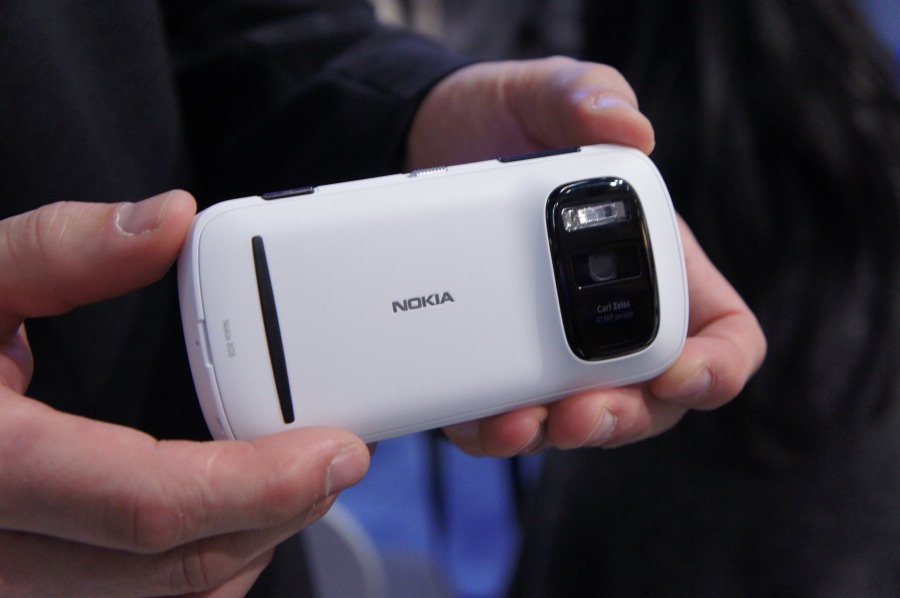The idea for this feature came while comparing photo taking on the Nexus 4 and Lumia 920, by the way, each large slab phones, and then picking up the Nokia 808 to take a photo and realising how much more comfortable it was. Leading me to propose that, for camera and camcorder duties, a phone should have the following attributes:
- Modest size. Over-size phones are clumsier to manipulate. And more intimidating for the subjects, possibly.
- Grippy texture. So many modern phones are style and materials-led, with the result that they're incredibly easy to drop. Grip is especially important when the device is large (as above). Recent culprits here are the Samsung Galaxy Nexus, S II and S III, for example.
- Camera glass which isn't easy to place fingerprints on. I spend half my life, it seems, carefully wiping the camera glass on touchscreen smartphones - the glass is often placed exactly where the tips of my fingers rest when using the device for normal smartphone tasks.
- Mechanical orientation. By which I mean that you can pick up the phone without looking and instantly get it the right way round, with left hand supporting the device without getting in the way of the optics and with your right finger on the shutter button. Slab phones like the Galaxy S III, Lumia 920, HTC 8X and, well, almost all current designs, are guilty here.
- Clear external display in all light conditions, so you can see what you're shooting. Although phone displays have come on in leaps and bounds in recent years (thanks partly to journalists like myself complaining bitterly, I suspect), there are still high end phones come out on which you can't clearly see what you're shooting when the sun's bright.
- Long enough battery life that you can use the device on the way to an event, shoot 100 photos there, plus a little video, then use the device normally all the way home. Bonus points for being able to swap in a new battery, or at least having one in your pocket 'just in case'.
Almost all 2012 smartphone fall foul of most of these, despite their 'Take the best photos ever!' advertising claims. Yet somehow other reviewers don't take these factors into consideration.
Staying within the Symbian world, even my beloved N8 falls well short, being very slippery (aluminium), having a slightly reflective display (it predated CBD) and having a nominally sealed 1200mAh battery. The Sony Ericsson Satio fared quite well, feeling good in the hand for camera work, at least, but wasn't that grippy and the screen was particularly poor outdoors.
The older N86 fares better in that you can swap the battery and it has camera glass protection, but battery life is rubbish so you've got to have a spare - or two, and the screen's not great in the sun. Go even further back to the previous camera-specialist Symbian smartphone, the N82, and you've got good overall size, texture, camera glass protection, clear display - but again, disappointing battery life. Plus that small 2.4" screen, as a viewfinder, is a strain on even the best eyes.

Which brings me, naturally, back to the Nokia 808 PureView:
- Modest overall size? Check.
- Grippy? Yep - the textured polycarbonate has meant that I've not dropped the 808 once when trying to take photos with it.
- Camera glass - well, it is exposed, but being raised up on the camera island means that fingers naturally curve round it, plus the actual glass is indented by a good millimetre from the metal bezel. I rarely find myself needing to clean the glass.
- Orientation - check. The camera island and shape of the back make it utterly obvious when picking up. I can pick it up 'blind' and instantly be correctly positioned to snap something.
- Display - check. In GSM Arena's tests (e.g. see the sunlight legibility chart here), the Nokia 808 beats every phone in the world by a huge margin. The 808 uses the latest version of the ClearBlack Display along with the RGB AMOLED screen and I'm often getting compliments from Galaxy S III and iPhone 4/5 owners saying how clear the 808's display is.
- Battery life? The 808's battery routinely lasts me two days per charge and it's never once failed on me during the heaviest day. Not that this stops me carrying around a spare BL-4D just in case, ready to slam in and carry on. You know me, belt and braces....
The fact that the Nokia 808 is, by some margin, the best camera and camcorder phone in the world in terms of performance, as well as having just about the perfect form factor, rather clinches the deal. I make no apologies for this gushing enthusiasm for the current Symbian flagship - it's in trying the competition (what I do every day of the year) that the strengths of what you have are emphasised. And I head out into the world this weekend with the Nokia 808 PureView proudly in my pocket.
It really is the last word in camera-centric smartphones, no matter what glossy adverts elsewhere may try to tell you. And it's hugely frustrating to see the 808 ignored in many round-ups simply because the reviewer has now dismissed Symbian as an OS. Thank goodness the 808 made it to market before Nokia closed down too much of its Symbian phone production!
_______________
PS. The biggest challenge about the Nokia 808 is actually buying one. Shortage of this classic model has pushed prices high - feel free to leave tips on where to buy one these days at a reasonable price!
No hay comentarios:
Publicar un comentario